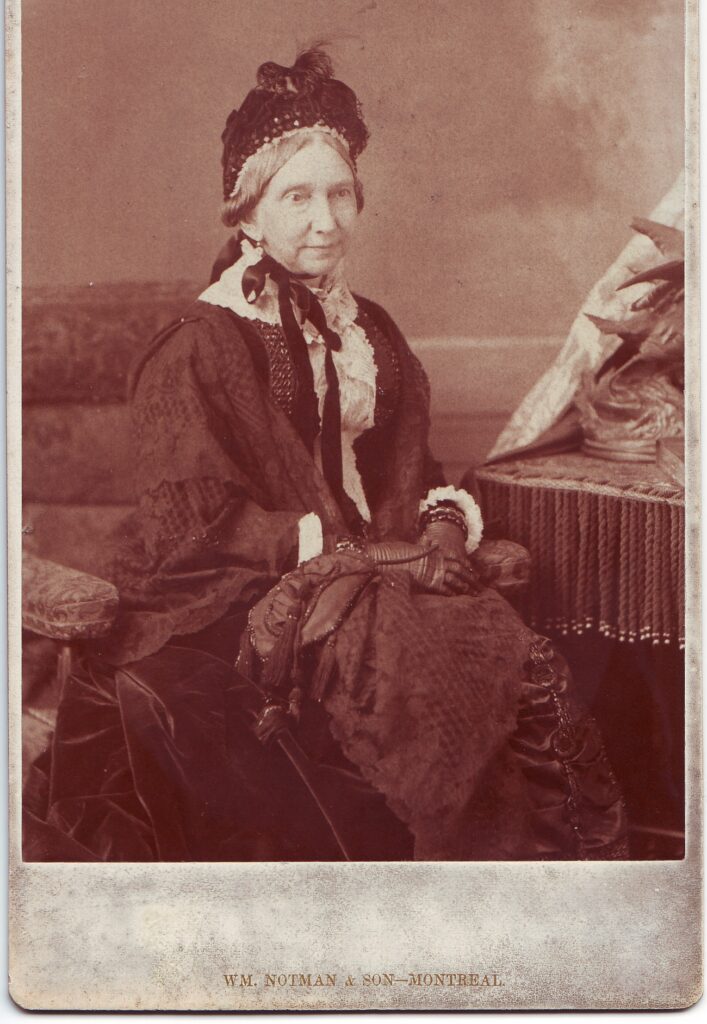
It was 3 a.m. and I was squinting at my reflection in the bathroom mirror, but it wasn’t just myself I saw. Without my glasses on, I recognized my mother’s eyes looking back at me, and the eyes of my great-great grandmother, Catharine Mitcheson Bagg.
As my mother aged, she had increasingly resembled the large portrait of Catharine that used to hang in my grandmother’s dining room; still, it was a shock to realize that Catharine’s features lived on in me too.
My mother told me she always felt that Catharine, dressed in mid-19th-century finery, stared down disapprovingly from her spot on the wall. Mother’s older cousin Clare had described Catharine as “terrifying.” Clare remembered visiting her in a dark and musty house on Sherbrooke Street, but at the time of the visit, Clare was about three years old and her great-grandmother was over 90, so it is no wonder she felt intimidated.
Catharine was born in 1822 and grew up on the outskirts of Philadelphia with her four siblings. Her English-born father was a merchant, her mother was from Scotland. Catharine’s education included sewing an intricate sampler when she was 10 and painting landscapes. In 1844, she married Stanley Clark Bagg, the grandson of her father’s oldest sister, and she moved to Montreal, where her new husband was a notary.
Stanley owned large tracts of land in Montreal that he had inherited from his grandfather, and, although the area was still primarily agricultural, he was starting to sell lots to would-be homeowners and developers. When he died of typhoid fever in 1873, at age 53, the eldest child and only son, Robert Stanley Bagg, a recent law graduate from McGill, took over management of the family real estate business. Over the years, his four sisters expressed opinions about when and what to sell and for how much, but he relied most on his mother’s advice.
When I came across some letters Catharine had written to her son, R. Stanley Bagg. I was thrilled. Suddenly this woman whose image I was so familiar with had a voice! They revealed her as a mother who worried about her son’s health, believed in the benefits of sea air and trusted that “all things work together for good in those who love God”.
She described her husband’s death as a calamity for the family, especially for Stanley who was “so young and inexperienced in the ways of the world.” And when Stanley retired after 27 years, she commended him for the “able, honourable and efficient manner” in which he had performed his arduous duties.
Another letter, dated 1889, was written on stationery from a hotel in Kennebunkport, Maine, an area I know well. Stanley and his young family were in Georgeville, Quebec. Catharine wrote, “You and Clara should have gone to some seaside place for several weeks this summer. Georgeville is not a sufficient change in air and scene.” Those words could just as easily have been written by my mother, or by me.
photo credit: McCord Museum
Research Remarks. Catharine Mitcheson was born on Jan. 12, 1822, according to her baptismal record. She was baptized at St. John’s Church, Northern Liberties, Philadelphia, and a copy of the church registers is available in the library of the Historical Society of Pennsylvania, in Philadelphia. The record of her marriage to Stanley Clark Bagg, at Grace Church, Philadelphia on Sept. 9, 1844 can be found on Ancestry.com. Catharine’s brother, Rev. Robert Mitcheson, officiated at the wedding.
Catharine died on Oct. 29, 1914 in Montreal, and the record of her funeral at Christ Church Cathedral is included in the Drouin Collection of church and vital records on Ancestry. She is buried in Mount Royal Cemetery.
A few letters she wrote to her son are in the Abner and Stanley Bagg fonds at the McCord Museum, Montreal.
The portrait of Catharine Mitcheson Bagg, painted in 1865 by artist William Sawyer (1820-1889), now belongs to the National Gallery of Canada. http://www.gallery.ca/en/see/collections/artwork.php?mkey=16157
